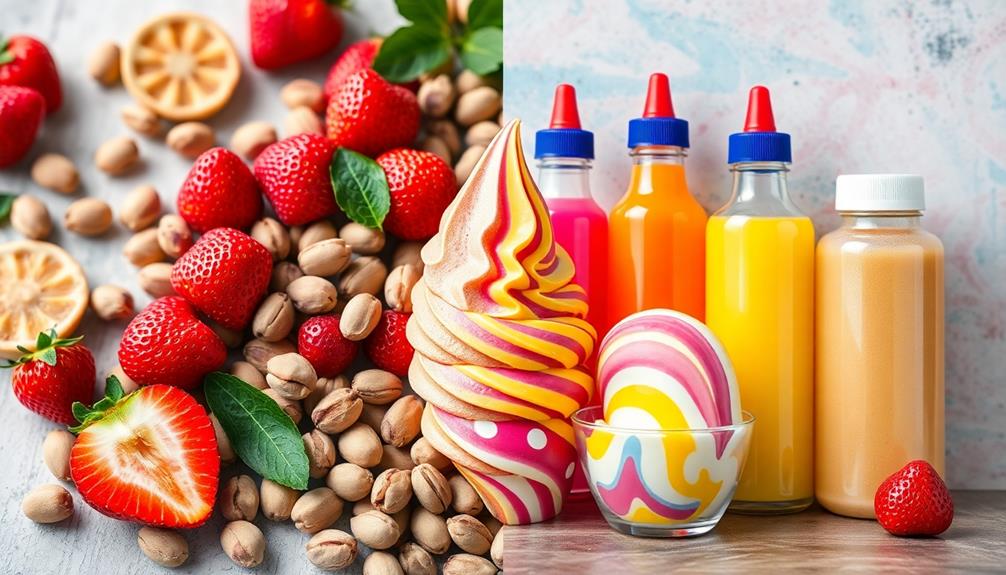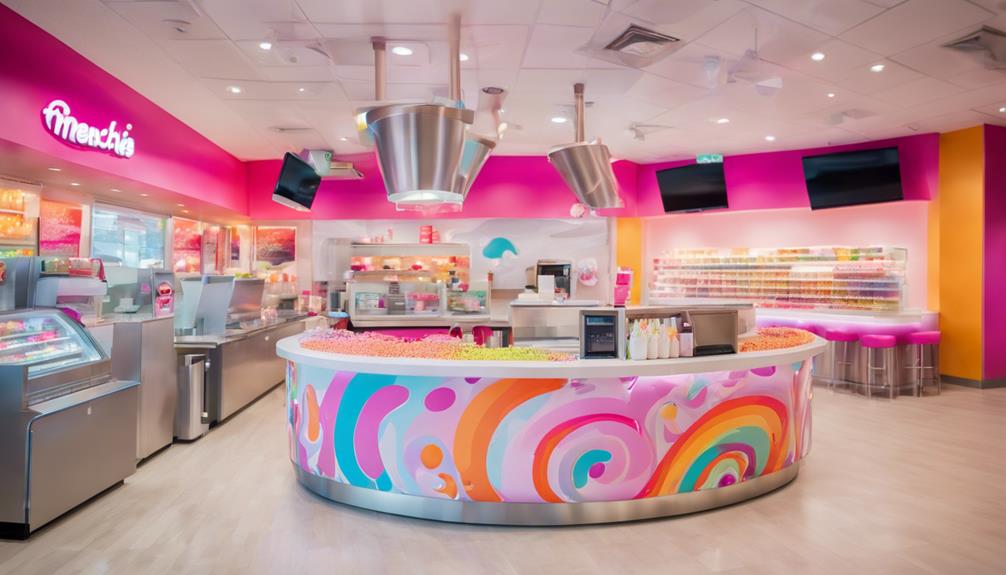When you explore the chemistry behind ice cream flavors, you'll find natural and artificial options both offer unique qualities. Natural flavors come from real fruits and spices, while artificial flavors are often synthesized from petroleum. Chemically, they can be quite similar, complicating perceptions of safety and health benefits. Many think natural flavors are healthier, but studies show no significant nutritional differences between the two. Furthermore, the production methods and environmental impacts vary widely. To better understand the balance between taste, health, and sustainability, keep uncovering the fascinating details behind these two flavoring worlds.
Key Takeaways
- Natural flavors are derived from edible sources, while artificial flavors are synthesized from petroleum and inedible substances, despite their chemical similarities.
- Flavorists analyze and blend both natural and artificial flavors to create appealing ice cream options, often enhancing flavors through dilution.
- Misconceptions exist about the safety of natural flavors versus artificial ones; both can contain harmful substances requiring informed consumer understanding.
- The extraction of natural flavors can lead to environmental concerns, while artificial flavors generally have a smaller ecological footprint.
- Consumer preferences lean towards natural flavors, yet studies reveal that many find artificial flavors more appealing, highlighting a gap between perception and taste.
Natural vs. Artificial Flavors
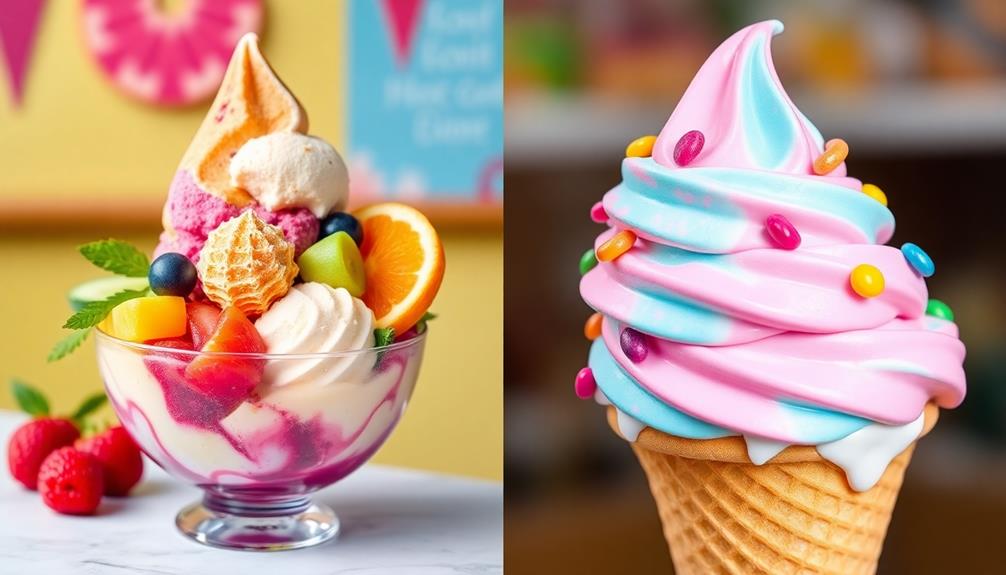
When you plunge into the world of ice cream flavors, you'll quickly notice the debate between natural and artificial flavors. Natural flavors come from edible sources like fruits and spices, while artificial flavors are synthesized from petroleum and other inedible substances.
Surprisingly, both types are chemically similar, often making it hard to distinguish them. The FDA doesn't require manufacturers to reveal specific ingredients in natural flavors, leading to a lack of transparency about their actual composition.
You might assume natural flavors are healthier, but it's crucial to know they can also contain synthetic chemicals. In fact, they often include over 100 flavoring constituents, including solvents and preservatives. This challenges the perception that they're purely "natural."
The market for flavors in processed foods generates around $24 billion annually, with flavorists crafting these food additives to enhance taste and consumer appeal.
Despite common misconceptions, studies show no significant nutritional difference between natural and artificial flavors. So, as you enjoy your ice cream, remember that the choice between natural and artificial flavors mightn't be as clear-cut as you think.
Role of Flavorists in Creation

Flavorists play a pivotal role in crafting the ice cream flavors you love. They analyze flavors on a molecular level, allowing them to identify and predict trends that lead to enticing flavor profiles.
To create these profiles, flavorists often blend natural and artificial flavors, seeking cost-effective alternatives to real ingredients. This is where synthetic chemicals come into play, enabling them to develop complex flavor systems that mimic the taste of genuine ingredients.
The flavor creation process is meticulous. Flavorists taste fresh samples, extract flavor components, and combine them with various notes to achieve the desired outcome.
They typically dilute flavor ingredients with water, glycerin, or ethanol, mimicking a large-scale kitchen environment during industrial production. This hands-on approach guarantees that the final ice cream products are consistently flavorful.
While you might see labels claiming natural flavors, it's important to remember that the blending process in labs often results in a combination of both natural and artificial components.
Flavorists are true artisans, merging science and creativity to bring you the delightful ice cream flavors you crave, all while maneuvering through the complexities of flavor ingredients.
Flavor Composition Explained
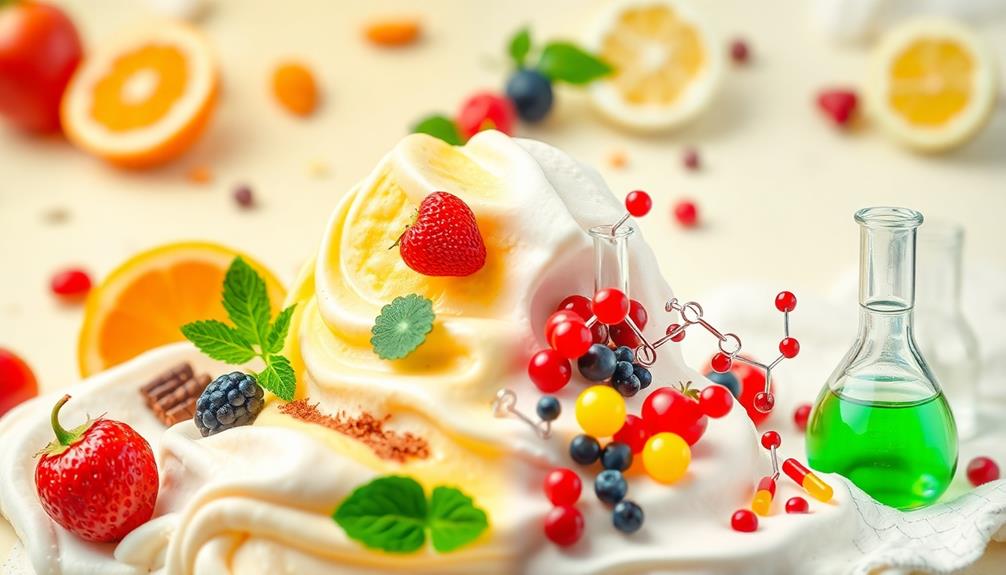
Understanding ice cream flavor composition is essential for appreciating what goes into your favorite treat. At the heart of this composition are natural and artificial flavors, each with unique characteristics. Natural flavors come from plant or animal sources and must be derived from edible materials, while artificial flavors are synthesized in labs to mimic these tastes using chemical compounds.
Here's a breakdown of the flavoring constituents:
- Natural Flavors: These flavors utilize various extraction methods like infusion and cold-pressing to capture intense aromas and tastes that artificial ingredients can't replicate.
- Artificial Flavors: Although they can mimic the taste of natural flavors, they may contain over 100 different chemicals, including solvents and preservatives.
- Cost and Perception: Natural flavors typically cost more due to sourcing and processing, leading many consumers to associate them with health benefits and authenticity.
Despite these differences, both natural and artificial flavors can have identical chemical structures, complicating perceptions surrounding "natural" in ice cream.
Understanding these nuances helps you make informed choices when indulging in this delightful dessert.
Health Implications and Perceptions
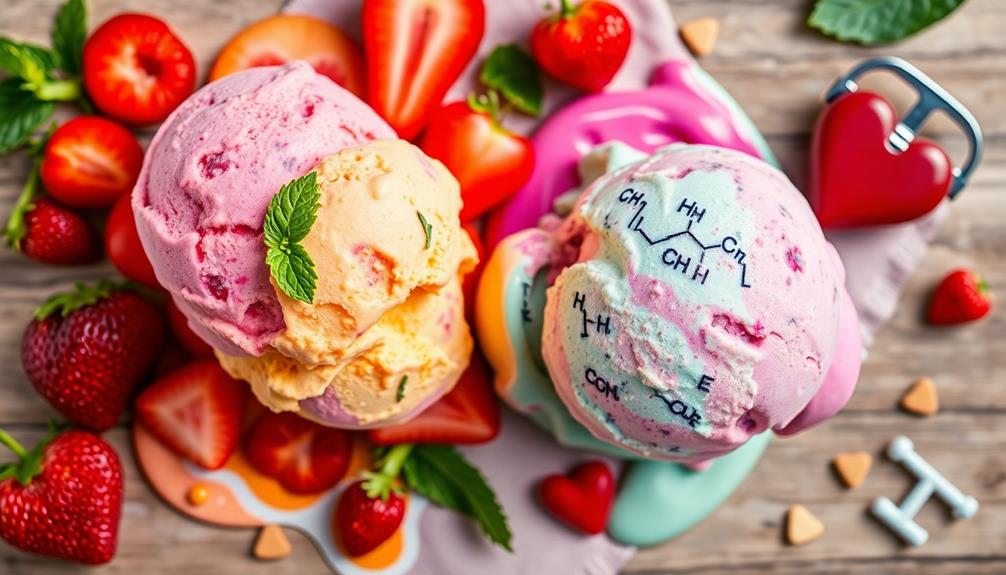
When you think about natural versus artificial flavors, your perception of health might lead you to believe that natural options are always safer.
However, misconceptions abound, as both types can contain harmful substances and may not offer significant health benefits.
It's essential to understand the safety concerns surrounding flavorings and the realities behind consumer preferences.
Flavor Safety Concerns
Steering through the world of ice cream flavors can be tricky, especially when it comes to safety concerns surrounding natural and artificial ingredients. You might assume that natural flavors are always safer, but that's not necessarily the case. Both types can pose health risks, and inadequate safety evaluations leave a lot of uncertainty.
Here are three key points to ponder:
- Ingredient Labeling: Regulations often don't require brands to disclose specific compounds in natural and artificial flavors, leading to consumer uncertainty about what's really in your ice cream.
- Health Risks: Some natural flavors can come from sources like bitter almonds, which contain cyanide. Meanwhile, artificial flavors may have simpler compositions, potentially making them less hazardous.
- Public Perception: Many people believe that natural flavors are healthier than their artificial counterparts. However, studies show no significant health advantages between the two.
In steering through these flavor choices, understanding the nuances behind natural and artificial flavors is essential. Awareness of safety evaluations can empower you to make informed decisions about what goes into your favorite ice cream treat.
Consumer Misunderstandings
Amid the ice cream aisle, many shoppers fall prey to misunderstandings about flavor safety and health implications. You might believe that natural flavors are healthier than artificial ones, but research shows no significant health advantage between the two. The safety of both flavor types often lacks thorough evaluation, leaving thousands of flavor chemicals unregulated by the FDA. This raises valid public health concerns.
Misleading marketing often influences your perception, making natural flavors seem safer, even though both types can share similar chemical structures and potentially harmful substances. Curiously, taste tests frequently reveal that artificial flavors can be perceived as more delicious, which contradicts the belief that natural flavors are superior based solely on health.
Here's a quick comparison to clarify these misconceptions:
| Flavor Type | Common Misunderstanding |
|---|---|
| Natural Flavors | Always healthier than artificial flavors |
| Artificial Flavors | Always less safe than natural flavors |
| Both Types | Share similar chemical structures |
| Safety | Not thoroughly evaluated by the FDA |
| Taste | Artificial flavors can be more delicious |
Understanding these nuances helps you make informed choices when selecting your favorite ice cream.
Health Perceptions Comparison
Over time, many consumers have developed a strong perception that natural flavors are inherently healthier than their artificial counterparts. This belief persists despite the fact that both types can share identical chemical structures and safety profiles.
Here's what you should consider:
- Safety Profiles: Artificial flavors often comprise safety-tested components, while natural flavors can sometimes harbor harmful substances, like cyanide, in certain extracts.
- Health Perceptions: Misconceptions about artificial flavors lead to negative health perceptions, even though they don't pose inherent health risks.
- Transparency Issues: The FDA doesn't require food manufacturers to disclose specific ingredients in natural flavors, leaving you unaware of potential allergens or harmful substances.
Public preference often sways toward natural flavors due to marketing influences, despite studies showing that many people find artificial flavors taste better.
This disconnect between perception and reality can complicate your understanding of what's genuinely healthy. Ultimately, it's crucial to look beyond the labels and marketing to evaluate the safety and health implications of both natural and artificial flavors in your ice cream choices.
Environmental Impact of Flavoring
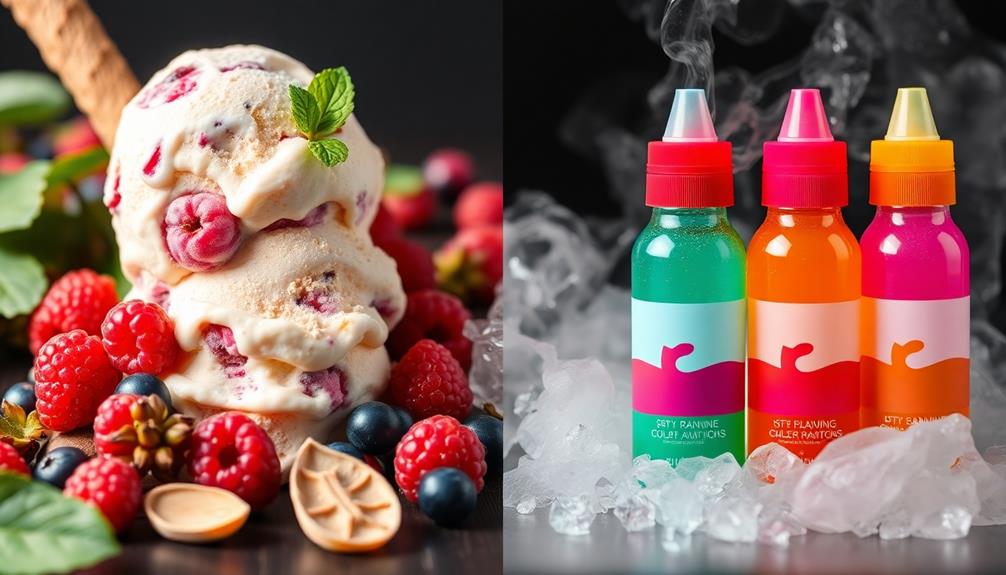
When you consider the flavors in your ice cream, think about where they come from.
The extraction of natural flavors often leads to environmental issues like deforestation and loss of biodiversity, while artificial flavors can reduce the need for resource extraction.
Finding a balance between these options is essential for sustainability in flavor production.
Resource Extraction Concerns
The environmental impact of flavoring, particularly through resource extraction, raises considerable concerns. When you opt for natural flavors, you're often supporting practices that can lead to environmental degradation, such as deforestation and loss of biodiversity.
Here are three key issues to reflect on:
- Harvesting Practices: The extraction of natural flavors may involve harmful practices that over-exploit certain species, raising sustainability concerns.
- Carbon Footprint: Collecting and processing these flavors usually requires notable transportation and energy, contributing to a larger carbon footprint.
- Ecological Impacts: Relying on natural flavors can have lasting ecological impacts, disrupting local ecosystems and threatening wildlife.
In contrast, artificial flavors are synthesized in laboratories, which considerably reduces the need for resource extraction.
This means they can potentially minimize ecological impacts while still delivering the taste you enjoy. Shifting to artificial flavors might be a viable solution to mitigate the negative environmental effects associated with natural flavor extraction.
Sustainability of Flavor Production
Sustainability in flavor production is increasingly essential as consumers become more aware of the environmental impacts of their choices. When it comes to natural flavors, the extraction processes often involve harvesting plant and animal materials, leading to environmental degradation like deforestation and loss of biodiversity.
The agricultural practices used to source these ingredients can also raise sustainability concerns, especially when they involve pesticide use and land degradation.
On the other hand, artificial flavors, produced in laboratory settings, usually have a smaller ecological footprint. They don't rely on the extraction of natural resources, making their production more efficient and consistent.
Additionally, since they can be synthesized with fewer carbon emissions, artificial flavors emerge as a more sustainable option in many cases.
As flavor science advances, researchers are developing more sustainable artificial flavors that further reduce the need for resource-intensive natural flavor extraction processes.
By understanding these differences, you can make informed choices about the flavors you enjoy, balancing taste with environmental responsibility.
Ultimately, exploring both natural and artificial flavors through a sustainability lens can guide you toward more eco-friendly ice cream options.
Flavor Creation Processes
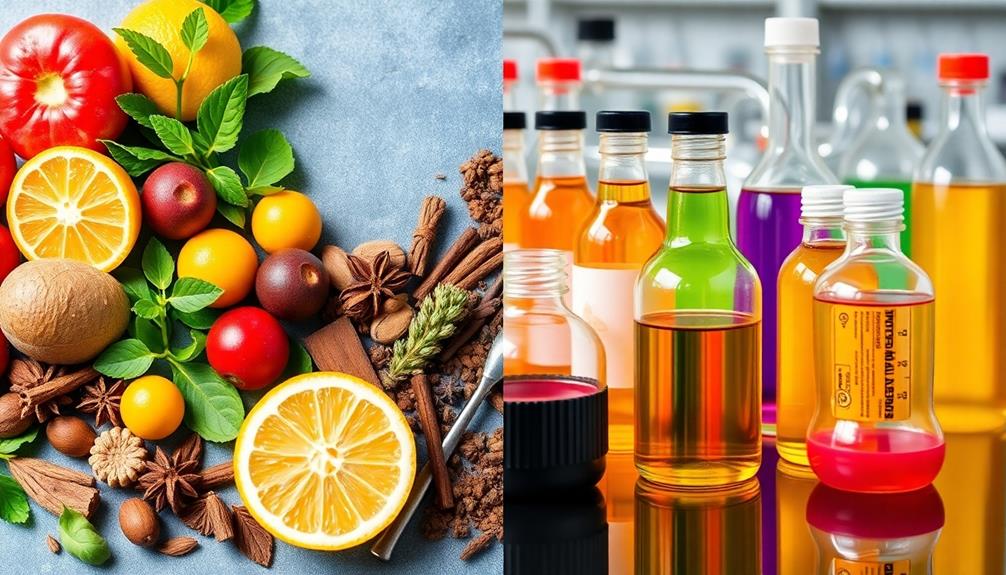
In creating ice cream flavors, producers start by tasting fresh fruit samples to uncover their unique flavor profiles. This initial step is vital in the flavor creation process, guiding the development of both natural and artificial flavors.
Once the flavor profiles are determined, the next steps include:
- Extraction: Flavor components from the fruit are extracted and blended with other notes, creating a complex flavor system.
- Enhancement: To boost the flavors, ingredients are often diluted with water, glycerin, or ethanol, allowing for a more concentrated flavor experience.
- Industrial Production: This entire process mimics a large-scale kitchen environment, where precise measurements and conditions are necessary for consistency.
While you may find products labeled as "natural," it's significant to recognize that many final flavor additives may involve lab blending processes that incorporate both natural and synthetic elements.
This blend guarantees that the flavors maintain their intended intensity and appeal, meeting consumer expectations. The flavor creation process is a blend of art and science, designed to satisfy your palate while balancing quality and efficiency in industrial production.
Food Labeling and Regulations
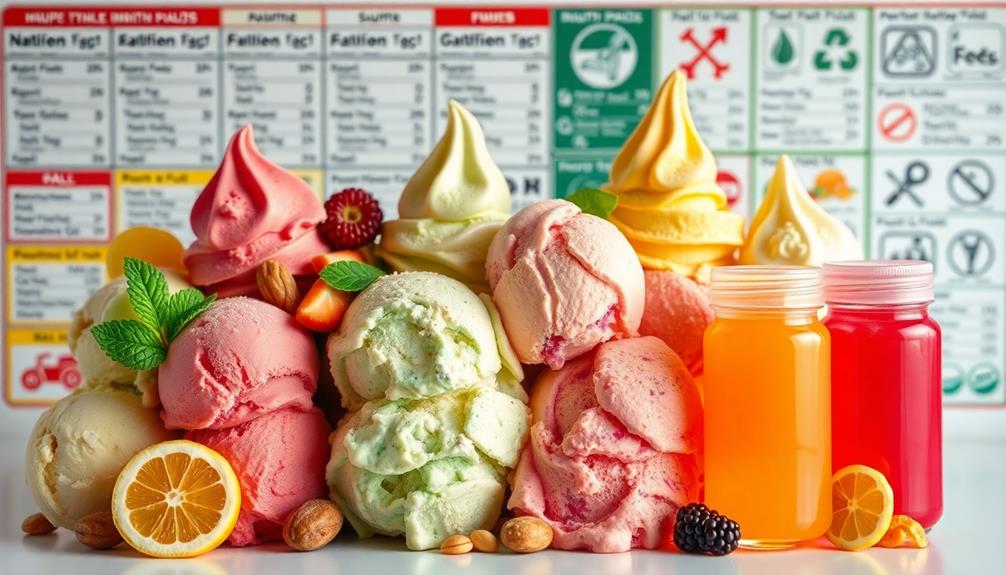
When you check food labels, you might notice that natural flavors don't always come with a clear list of ingredients.
The FDA's regulations allow for this lack of transparency, leaving you in the dark about what's really in your ice cream.
Understanding these gaps in oversight can help you make more informed choices about what you eat.
Ingredient Disclosure Challenges
Ingredient disclosure challenges in food labeling and regulations create confusion for consumers trying to make informed choices.
When you glance at food labels, particularly for ice cream, you may wonder what "natural flavors" really means. The FDA doesn't require manufacturers to specify the chemical structures behind these flavors, leaving you in the dark about what you're consuming.
Understanding the implications of common financial terms can also aid in making healthier choices without overspending on processed foods.
Here are three key points to evaluate:
- Ambiguity in Definitions: Natural flavors must come from plant or animal sources, but they can still include synthetic chemicals, complicating the notion of "natural" on labels.
- Lack of Transparency: Retailers like Whole Foods may ban certain ingredients, but the specifics of what constitutes natural flavors often remain unclear, hampering consumer transparency.
- Allergens vs. Flavor Ingredients: While common allergens are listed, the details of flavoring agents often aren't, requiring you to contact manufacturers directly for clarification.
Ultimately, cooking from scratch remains the most reliable way for you to know exactly what's in your food, helping you navigate the ingredient disclosure challenges of processed foods.
Regulatory Oversight Gaps
Maneuvering the complexities of food labeling reveals significant regulatory oversight gaps, especially concerning flavor ingredients. The Food and Drug Administration (FDA) doesn't require detailed disclosure of specific ingredients in natural flavors. This lack of transparency can lead to consumer confusion about what you're really consuming.
While common allergens must be listed, many other ingredients, particularly in flavorings, might remain undisclosed unless you directly request that information from manufacturers.
The absence of clear definitions for what constitutes "natural" complicates your understanding and trust in flavor sources. When you see "natural flavors" or "artificial flavors" on an ice cream label, it's often unclear what that really means.
While the Environmental Working Group (EWG) scores both types similarly, organic natural flavors tend to receive slightly better ratings due to stricter production standards.
Ultimately, the lack of stringent regulations on flavor labeling raises concerns about the safety and integrity of the ingredients used in processed foods. You deserve clarity and reassurance about what goes into your food, yet these regulatory oversight gaps make that challenging.
Transparency in Labeling
Transparency in labeling is essential for informed consumer choices, yet many ice cream labels fall short. Food manufacturers often hide behind vague terms, especially when it comes to natural flavors. You might think you're choosing a healthier option, but that label can be misleading.
Here are three key points to reflect on:
- Hidden Ingredients: The FDA doesn't require food manufacturers to disclose the specific ingredients in natural flavors, leaving you in the dark.
- Allergen Awareness: While common allergens must be listed, other components in natural flavors mightn't be, prompting you to reach out to manufacturers for clarification.
- Complex Definitions: Natural flavors can include synthetic chemicals derived from natural sources, complicating your understanding of what you're consuming.
Many retailers, like Whole Foods, have ingredient bans, but they often lack clarity on what constitutes natural or artificial flavors.
Given these ambiguities in labeling regulations, cooking from scratch remains the most reliable way to know exactly what's in your ice cream. When you take charge of your ingredients, you guarantee your choices align with your health goals and preferences.
Consumer Awareness and Trust
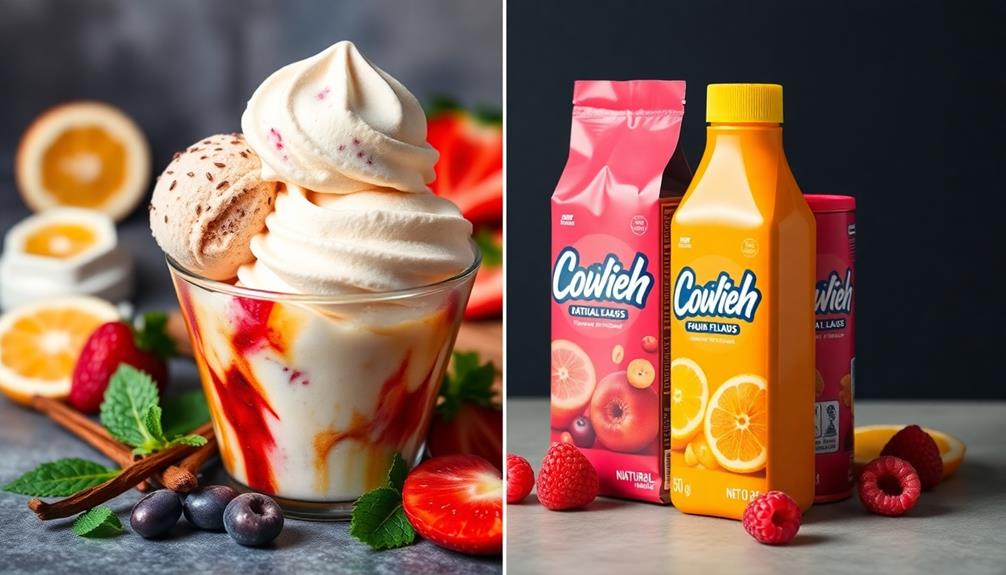
When it comes to ice cream flavors, many consumers lean towards natural options, believing they're healthier and more trustworthy than artificial ones. This belief often stems from the perception that natural flavors are superior, despite studies showing no significant nutritional differences between the two.
The lack of transparency in food labeling complicates matters, as consumers frequently encounter vague descriptions of what constitutes natural flavors. The FDA doesn't require detailed disclosure of the chemical components in these flavors, which can create confusion and mistrust. You might find yourself questioning what's truly in your favorite ice cream.
Public perception often tilts in favor of natural flavors, driven by marketing strategies that promote health and authenticity. This can lead to misunderstandings about the safety of artificial flavors.
To foster consumer trust, it's vital to educate yourself on flavor chemistry and demand greater transparency in ingredient sourcing. Understanding the true nature of both natural and artificial flavors can help you make informed choices.
In a world where health perception heavily influences purchasing decisions, being aware of the facts can empower you to navigate the ice cream aisle with confidence.
Market Trends in Flavoring
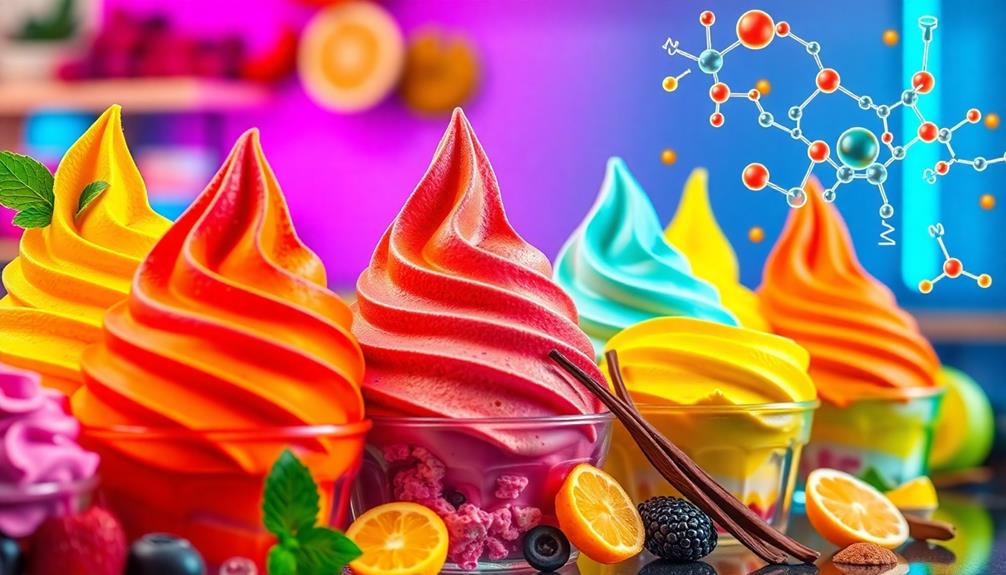
In recent years, the ice cream market has seen a notable shift towards natural flavors, driven by a growing consumer demand for healthier and more authentic ingredients. This trend reflects a broader movement toward health-conscious eating, with many consumers willing to pay more for products that boast natural ingredients.
Here are three key market trends shaping flavoring choices:
- Consumer Preferences: About 60% of consumers prefer natural flavors over artificial ones when it comes to their ice cream choices.
- Market Growth: The global market for natural flavors is projected to hit $23 billion by 2026, indicating a significant shift away from artificial flavoring agents.
- Flavor Profiles: Flavorists are vital in developing unique and appealing flavor profiles that cater to this demand, with over 500 professionals enhancing both natural and artificial offerings.
However, ice cream manufacturers face challenges. The cost of sourcing natural flavors can be up to three times more than artificial options, pushing them to balance quality with affordability.
Adapting to these market trends is essential for staying competitive in a rapidly evolving landscape.
Shelf Life Considerations
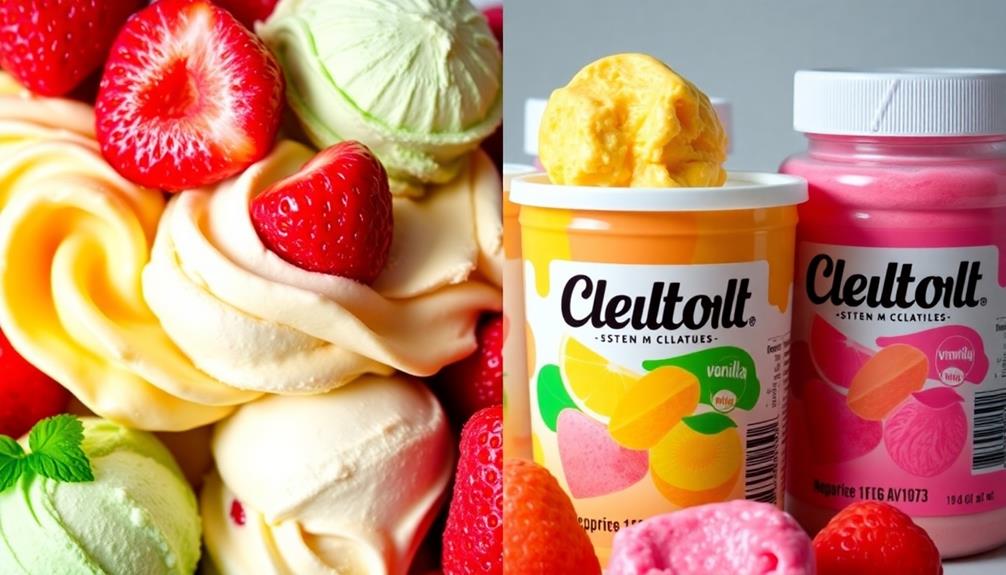
Maintaining the freshness of ice cream is essential, especially when it comes to the choice between natural and artificial flavors. Natural flavors often have a shorter shelf life due to their susceptibility to degradation over time. This makes preservation a significant challenge for manufacturers, as the flavor quality can diminish quickly.
If you opt for ice cream with natural flavors, be aware that it may require more careful storage conditions to maintain its taste and freshness.
On the other hand, artificial flavors are more chemically stable and can withstand longer shelf life without a significant loss in flavor quality. This stability means ice creams made with artificial flavors can provide consistent taste over time, reducing the need for frequent production cycles.
Fresh juices and ingredients used for natural flavors may lose their flavor quality faster than their synthesized counterparts, complicating the preservation process.
Frequently Asked Questions
Are Natural Flavors Better for You Than Artificial Flavors?
You might believe natural flavors are healthier, but they can contain synthetic chemicals too. Both types can enhance taste similarly, so it's crucial to evaluate the overall quality of the ingredients rather than labels alone.
Are Natural Flavors Chemically Made?
Yes, natural flavors can be chemically made. They're often derived from plants or animals, but the processes used to create them might involve synthetic chemicals, blurring the line between truly natural and artificially produced flavors.
Are Natural Flavors Made in a Lab?
Absolutely, natural flavors can be crafted in a lab. While they're marketed as wholesome, many undergo significant synthetic synthesis, blending botanical sources with laboratory-labored components, blurring boundaries between what's truly natural and what's artificially assembled.
What Is the Chemical Formula for Artificial Flavors?
Artificial flavors can vary widely in their chemical formulas. For instance, vanillin is C8H8O3, while ethyl butyrate, mimicking pineapple, has the formula C5H10O2. Understanding these formulas helps you assess their safety and compliance.
Conclusion
In the world of ice cream, flavors are like the colors on a painter's palette, each hue telling its own story. Whether you savor the vibrant notes of natural ingredients or indulge in the bold whispers of artificial concoctions, the choice reflects your taste and values. As you scoop your next cone, remember that every flavor carries a journey—one of creativity, health, and the environment. Choose wisely, and let your taste buds commence on a delicious adventure.
